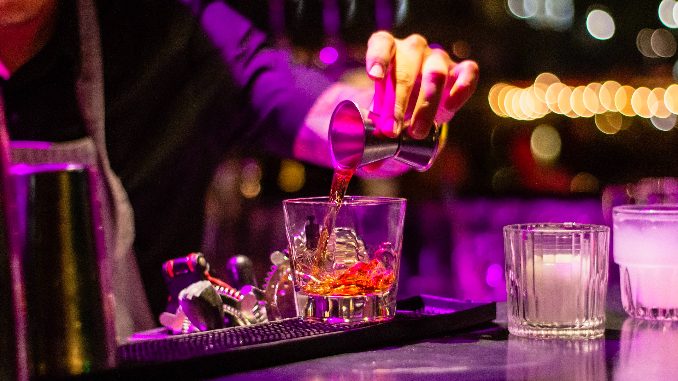Though the indie sleaze era may be conceptualized as a fashion movement, I feel like the style so typical of late 2000s and early 2010s actually isn’t too far off from what young people are wearing now. An aspect of culture that has seen a much, much larger shift is the world of drinks. Canned seltzers, martinis and low-ABV beverages are a far cry from the party-approved drinks of the early Obama era. And as we start donning our oversized flannels and wide-brimmed hats again, I have a hard time believing some of the most popular drinks of the era will make a resurgence post-pandemic. Though the recent rise of the martini marks a shift toward heavier, more indulgent drinking, it still has a sense of elegance to it that the drinks popularized by young people in the late aughts could never touch.
I’ve decided to revisit some of these drinks to remind myself why I should never, ever drink them again. If you’re still drinking this stuff, I commend you—you have a stronger liver than I. Here’s some of what we were drinking during the original indie sleaze era.
Four Loko
If I had to think of one drink that typified this time, it has to be the infamous Four Loko. The drink got most of its bad press pre-2010, which is when the company decided to stop adding caffeine to its highly flavored malt liquor concoctions after multiple Four Loko-related deaths hit the news. Luckily, I wasn’t old enough to have ever gotten my hands on the caffeinated version, but I can speak with authority when I say that even the caffeine-free variety was shockingly strong. Just one can could contain the equivalent of five and a half standard drinks.
Clearly, it was a go-to for younger drinkers on a budget, but it came with a steep price: an artificial-tasting flavor that was so sweet, you didn’t know whether the sugar or the alcohol was more responsible for your hangover the next day. Though I’m not a huge fan of spiked seltzers, I would take a mellow alcoholic Spindrift over one of these canned bad boys any day. My stomach hurts just thinking about them.
Vodka Red Bull
As you can tell, the alcohol-caffeine combo was popular in the late 2000s. Maybe the party-all-night mentality broke us, but staying up late enough to drink all night seemed like a priority at the time. These days, I am an outspoken critic of the espresso martini specifically because if I drink caffeine and alcohol together, there’s a 50/50 chance I’m going to have a panic attack by the end of the night. But for some reason, that wasn’t a concern a decade ago. Hence, the vodka Red Bull.
The flavor wasn’t really the point. Red Bull is too sweet and has always been too sweet. I think the idea of the vodka was just efficiency. I don’t think anyone genuinely sipped on their vodka Red Bull and enjoyed the process, sadly.
Jägerbombs
I don’t have any clue why Jägermeister became so popular during this time, but it was everywhere. And though I remember that plenty of people would simply take shots of it, I mostly saw it in its most degraded form: the Jägerbomb. Basically, you would drop a shot of Jäger into an energy drink and down it in one go. Again, this one seems like it’s all about the efficiency, but I’m not really sure why the highly flavored Jägermeister, a German digestif that’s been around since 1934, seemed like the way to go. I was never a big fan of Jägerbombs, but I it’s safe to say that it’s been years since I heard someone order them at a crowded bar.
Mike’s Hard Lemonade
Okay, this one may have been because I am on the younger end of the Millennial spectrum, but when I was in college, there were Mike’s Hard Lemonades at Every. Single. Party. To me, Mike’s Hards are the closest thing we had to the seltzers of today. They were low in alcohol and easy to drink a lot of without getting sick. In fact, the sugar would generally make me feel woozy before the alcohol itself did. Over time, they started releasing stronger drinks, but it’s been a long time since I’ve seen anyone buy a six-pack of these things. They were kind of gross, but I can’t help feeling like alcoholic lemonade actually wasn’t too bad of an idea.
MD 20/20
MD 20/20, which stands for Mogen David but was popularized as “Mad Dog,” is a fortified wine pumped full of artificial coloring. For the generation raised on Kool-Aid, this drink made sense: We loved the fun colors and aggressive flavors. I think the most iconic version was the Blue Raspberry flavor—the electric blue color was such a specific vibe. I probably don’t need to tell you that it didn’t taste very good, but I’m guessing that its intense fruitiness made it appealing to those who genuinely just hated the taste of alcohol and were willing to cover it at all costs. Of all of these drinks, I think MD 20/20 probably has the most long-term staying power: It’s a classic but preferably one you eventually outgrow.
Samantha Maxwell is a food writer and editor based in Boston. Follow her on Twitter at @samseating.
